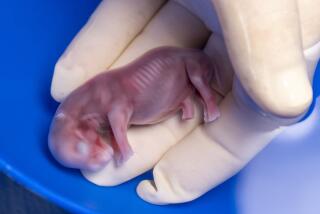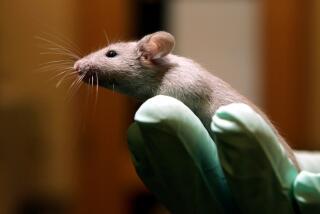In vitro fertilization goes to the dogs

Alex Travis, associate professor of reproductive biology, discusses his breakthrough with the world’s first litter of puppies born via in vitro fertilization.
It’s official: In vitro fertilization is no longer a treatment reserved for making small humans. The assisted reproduction technique that has led to the birth of more than 5 million human babies around the world can now be used to produce puppies.
In work expected to further efforts to preserve endangered wildlife and enhance human health, scientists at Cornell University have succeeded in joining canine egg and sperm, creating embryos, implanting them in the uterus of a female carrier and seeing the gestation of those puppies-to-be to birth.
See the most-read stories in Science this hour >>
The successful birth of seven healthy puppies ended about two decades of failed efforts to make the commonly used infertility treatment work on canines, whose reproductive biology differs from that of humans in a wide range of particulars. In humans, physicians have made a science -- and a booming business -- of stimulating egg growth, retrieving oocytes, introducing egg and sperm, cultivating the resulting proto-embryos in laboratory medium and transferring blastocysts to a woman’s uterus.
But that multi-step process needed to be tweaked at many points for success to be achieved in dogs. Success was achieved after 19 embryos were transferred into a healthy host female beagle and, after a period of about 63 days, seven healthy pups were delivered by Caesarian section.
Report of the new research was published Wednesday in the journal PLoS One.
Pierre Comizzoli, a research veterinarian at the Smithsonian Institution’s Conservation Biology Institute, said the work will offer vital insights into the varied reproductive biologies of many animals. There are 5,500 mammalian species, but scientists have only characterized in detail the biologies of about 100 of them.
For conservation biologists intent on bringing a wide range of endangered mammalian species back from the brink, the project should offer new perspectives on techniques that work, said Comizzoli, who is not among the authors but has been the Smithsonian’s point person for joint work with Cornell on the topic.
For human health too, the new work may bring discoveries. Domestic dogs share with humans many diseases, including cancers, diabetes and genetic disorders. So their response to experimental treatments can offer useful insights into the likely outcomes of those treatments in humans.
At the cusp of a new era in which disease-related genes might be edited out of a human’s genome, dogs already have provided an important model for experimentation. Because gene editing is done in the laboratory, only with the success of IVF in canines can the animals become a useful test bed for editing changes that might -- pending much ethical and scientific debate -- be used in humans.
Follow me on Twitter @LATMelissaHealy and “like” Los Angeles Times Science & Health on Facebook.
MORE SCIENCE NEWS
CDC grades American schools on how well they teach sex education
Signs of depression are ‘unacceptably high’ among doctors in training, study finds
Laziness and lack of sleep can shorten your life, especially when combined, study says







